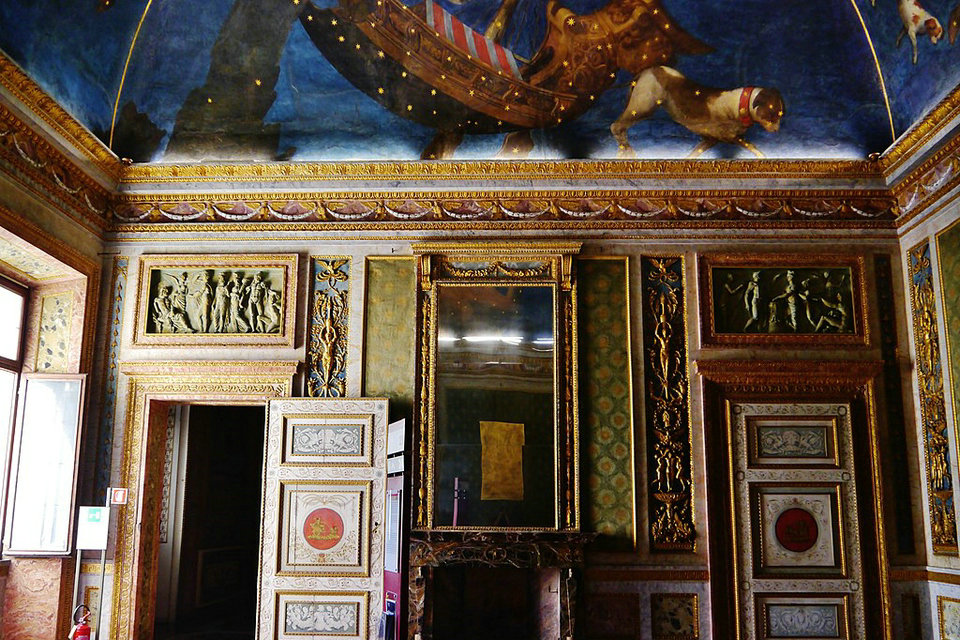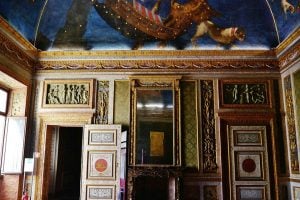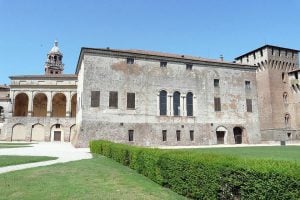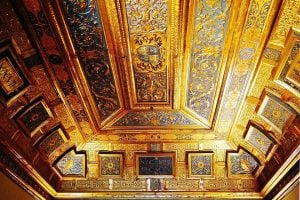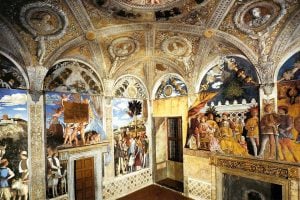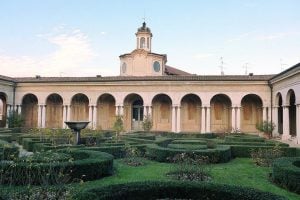The Zodiac Room (Sala dello Zodiaco) was the bedroom of Guglielmo Gonzaga and one of the most interesting rooms in the palace. It has an astronomical fresco of Diana’s chariot pulled by dogs among the constellations painted on the ceiling by Lorenzo Costa the Younger in 1579. The room also served as Napoleon’s bedroom during the Napoleonic Wars.
In the Habsburg era, the Refectory was the subject of a restructuring that led to the creation of the Sala dei Fiumi where, painted on the walls in the form of giants by Giorgio Anselmi, the rivers of the Mantuan territory are represented. At the same time, the Four-Room Tapestry Apartment was built. On the walls of three of these, nine tapestries are hand-woven in Flanders on cartoons with Raphael’s preparatory drawing, the same used for the well-known Raphaelesque tapestries preserved in the Vatican. They were bought in Brussels by Cardinal Ercole Gonzagain the first half of the sixteenth century to furnish the environment then called ” Green Apartment “. The Flemish tapestries after having also decorated the Palatine Basilica of Santa Barbara and finished forgotten in the warehouses of the Ducal Palace, were restored in 1799 and placed in the apartment adapted for them.
A further restructuring of the Napoleonic era also concerned the Sala dello Zodiaco which in any case preserved the ceiling frescoed by Lorenzo Costa the Younger in 1579. The hall was also known as Napoleon’s, as it was Bonaparte’s bedroom. The crater (cup) of sacrifices and libationsalludes to the immortality of the Gonzaga family. The Raven, a bird sacred to Apollo, was transformed into a constellation by the god. The sign of the Virgin, with the ear in hand, takes on the appearance of Astrea and Ceres and is the emblem of Vincenzo Gonzaga. The firmament revolves around Diana’s chariot, pulled by a pack of dogs. The pregnant goddess is the transfiguration of Eleonora of Austria, wife of the Duke of Mantua. According to ancient tradition, the Scorpion holds the sign of Libra in its claws.
Guglielmo Gonzaga
Guglielmo Gonzaga (24 April 1538 – 14 August 1587) was Duke of Mantua from 1550 to 1587, and of Montferrat from 1574 to 1587. He was the second son of Federico II Gonzaga, Duke of Mantua and Margaret Palaeologina of Montferrat. In 1574, Montferrat was elevated to a Duchy and Guglielmo became its first duke. He was succeeded as Duke of both duchies by his son Vincenzo.
Biography
When his father died on June 28, 1540, Guglielmo was placed with his brothers under the protection of his mother and paternal uncles, Cardinal Ercole and the imperial lieutenant and viceroy of Sicily Ferrante. Like many members of the Gonzaga second-born family, he was assigned to the ecclesiastical career, where he was immediately directed to activities and convenient studies on that path. But his fate changed on 21 February 1550 when, with the tragic end of his brother Duke Francesco , who died following a trivial hunting accident, Guglielmo Gonzaga became the recipient of the ducal throne. With the Treaty of Cateau-Cambrésis the lordship on the Monferrato was confirmed. In 1569 he subjected Casale , always jealous of its autonomy with respect to Monferrato, with a fierce repression. In 1573 he became duke, from Marquis who was, also from Monferrato, from 1561 Guglielmo appointed his sister Isabella to the government of Monferrato, who , being wife of the governor of Milan Francesco Ferdinando d’Avalos , could guarantee the defense of the State thanks to a excellent organization of Monferrato troops.
He was a good administrator of his domains, a patron of the arts, a musician (he himself was a composer) and a collector of works of art. He also took great care of the army. He was shrewd and political, able to remain independent of the potentates of the time (Papacy, Empire, powers such as Spain and France); during the government of Guglielmo Gonzaga, the Duchy of Mantua was definitively transformed into a real State in all respects, a process started by Cardinal Ercolein 1540. This change affected every sector of the state apparatus, from the political administration to the cultural life of the court, and also from military and religious activities. The modernization of the state apparatus promoted and created by the Duke of Mantua remained substantially unchanged until 1708 , even during the period of the War of 1630. Increased agricultural and industrial production, intensifying trade. The city of Mantua , in 1567 , had 64,000 inhabitants. In the same year, Duke Guglielmo unleashed a great wave of repression in the Monferrato area, against the autonomist tendencies. On 3 October the duke escaped from Casale in a plot that aimed to kill him, during the settlement of the new bishop Ambrogio Aldegati. After some time, other threats came to the Duke Guglielmo from the family, when around 1576 his brother Ludovico Gonzaga claimed the Piedmontese territories as part of the assets that he was entitled to for a maternal inheritance. With a determined diplomatic action at the imperial court and with the support of the court of Madrid , in 1578 the Duke Guglielmo obtained from the emperor once again a favorable response towards the Duke of Mantua. Subsequently the duke asked the pope to withdraw the inquisitor Camillo Campeggio , following popular protests caused by his rigidity, by sending a special ambassador to Rome, Teodoro Sangiorgio. The citizens also attacked the friars at night and killed three. In 1571 the duke visited Venice, where he signed an agreement for the mutual extradition of criminals; in 1573 Guglielmo Gonzaga obtained the imperial investiture of the marquisate of Gazzuolo and was crowned in Mantua.
Under his reign, in 1575 , Guglielmo obtained an important concession from the emperor in the modification of the Gonzaga coat of arms: the position of the eagles changed, going from revolts to the heraldic right to faced and no longer with the lowered flight.
In 1586 he had the poet Torquato Tasso released and received at his court , imprisoned in Ferrara by his son-in-law Duke Alfonso II d’Este during his wedding. Among the illustrious guests during the duchy of Guglielmo at least remember the coming to Mantua of Henry III of Valois , who was going to Paris for his coronation after the death of Charles IX. The monarch arrived in Mantua in 1574 from Venice, on a bucintoro , received by three thousand arquebusiers at Palazzo Te , where he received extraordinary hospitality. The dowry given to his daughter Anna Caterina was also the director, who in 1582 married Ferdinand of Habsburg , brother of the emperor, from whom he perhaps expected the ambitious “royal treatment” of the Grand Duke.
Under his rule Mantua became one of the most splendid and prestigious courts of Europe and Guglielmo managed to accumulate a colossal fortune, also consisting of two million gold coins. He had the Basilica Palatina di Santa Barbara and the country houses of Marmirolo and Goito built in the ducal palace of Mantua.
He died August 14, 1587 in Goito and the following Saturday the body was transported in a litter to Mantua, accompanied by the ducal Guard. The following Tuesday the Duke was imprisoned in a coffin adorned with a golden brocade drape, with two cushions supporting his portrait, and with the signs of his power. The coffin was placed on a catafalque formed by four pyramids, with many torches lit; in the evening at twenty-four o’clock private funeral began which lasted until three o’clock the following night. The solemn funeral took place the next day in St. Peter’s Square; on September 22 a naval battle was staged in the Lago di Sopra , to celebrate the coronation of the new duke Vincenzo. He was buried in the palatine basilica of Santa Barbara.
Duke Guglielmo, thanks to the wise and careful administration of the duchy, left Prince Vincenzo, a huge state patrimony of 1,000,000 scudi , a figure that was later increased despite the libertine and sclap-like lifestyle of his successor Vincenzo I.
Marriage and children
On 26 April 1561 William married Eleonora of Austria, sixth daughter of Ferdinand I, Holy Roman Emperor and Anna of Bohemia and Hungary. They were parents to three children:
Vincenzo I (21 September 1562 – 9 February 1612). Married Eleonora de’ Medici (Eleanor’s niece).
Margherita Gonzaga (27 May 1564 – 6 January 1618). Married Alfonso II d’Este.
Anna Caterina Gonzaga (17 January 1566 – 3 August 1621). Married her maternal uncle Ferdinand II, Archduke of Austria.
Patron of music
Guglielmo was particularly interested in sacred vocal music, and is known particularly to music historians for his extensive correspondence with the composer Giovanni Pierluigi da Palestrina. He built a large new church in Mantua, dedicated to Santa Barbara. He engaged in an unprecedented negotiation with the Papacy to create his own rite for Mantua, and devoted considerable resources to developing a musical repertoire for the church, commissioning works by Giaches de Wert and Palestrina. Part of his correspondence with Palestrina discusses the work commissioned in detail, stipulating Guglielmo’s requirements, and therefore giving a sense of his musical preferences. Guglielmo’s musical tastes were conservative for the day. He enjoyed imitative contrapuntal music but was concerned to maintain clarity of text, thereby showing the influence of Tridentine reforms. Upon his death, his son Vincent invited followers of the more modern trends to his court.
Dome
Diana on the chariot pulled by dogs, vault of the Zodiac hall, is an astronomical fresco of Diana’s chariot pulled by dogs among the constellations painted on the ceiling by Lorenzo Costa the Younger in 1579.
Diana is a Roman goddess of the hunt, the Moon, and nature, associated with wild animals and woodland. She is equated with the Greek goddess Artemis, and absorbed much of Artemis’ mythology early in Roman history, including a birth on the island of Delos to parents Jupiter and Latona, and a twin brother, Apollo, though she had an independent origin in Italy.
Diana was known as the virgin goddess of childbirth and women. She was one of the three maiden goddesses, along with Minerva and Vesta, who swore never to marry. Oak groves and deer were especially sacred to her. Diana made up a triad with two other Roman deities; Egeria the water nymph, her servant and assistant midwife; and Virbius, the woodland god.
Diana is revered in modern Neopagan religions including Roman Neopaganism, Stregheria, and Wicca. From the medieval to the modern period, as folklore attached to her developed and was eventually adapted into neopagan religions, the mythology surrounding Diana grew to include a consort (Lucifer) and daughter (Aradia), figures sometimes recognized by modern traditions. In the ancient, medieval, and modern periods, Diana has been considered a triple deity, merged with a goddess of the moon (Luna/Selene) and the underworld (usually Hecate).
The persona of Diana is complex, and contains a number of archaic features. Diana was originally considered to be a goddess of the wilderness and of the hunt, a central sport in both Roman and Greek culture. Early Roman inscriptions to Diana celebrated her primarily as a huntress and patron of hunters. Later, in the Hellenistic period, Diana came to be equally or more revered as a goddess not of the wild woodland but of the “tame” countryside, or villa rustica, the idealization of which was common in Greek thought and poetry. This dual role as goddess of both civilization and the wild, and therefore the civilized countryside, first applied to the Greek goddess Artemis (for example, in the 3rd century BCE poetry of Anacreon). By the 3rd century CE, after Greek influence had a profound impact on Roman religion, Diana had been almost fully combined with Artemis and took on many of her attributes, both in her spiritual domains and in the description of her appearance. The Roman poet Nemesianus wrote a typical description of Diana: She carried a bow and a quiver full of golden arrows, wore a golden cloak, purple half-boots, and a belt with a jeweled buckle to hold her tunic together, and wore her hair gathered in a ribbon.
As a triple goddess
Diana was often considered an aspect of a triple goddess, known as Diana triformis: Diana, Luna, and Hecate. According to historian C.M. Green, “these were neither different goddesses nor an amalgamation of different goddesses. They were Diana…Diana as huntress, Diana as the moon, Diana of the underworld.” At her sacred grove on the shores of Lake Nemi, Diana was venerated as a triple goddess beginning in the late 6th century BCE.
Andreas Alföldi interpreted an image on a late Republican coin as the Latin Diana “conceived as a threefold unity of the divine huntress, the Moon goddess and the goddess of the nether world, Hekate”. This coin, minted by P. Accoleius Lariscolus in 43 BCE, has been acknowledged as representing an archaic statue of Diana Nemorensis. It represents Artemis with the bow at one extremity, Luna-Selene with flowers at the other and a central deity not immediately identifiable, all united by a horizontal bar. The iconographical analysis allows the dating of this image to the 6th century at which time there are Etruscan models. The coin shows that the triple goddess cult image still stood in the lucus of Nemi in 43 BCE. Lake Nemi was called Triviae lacus by Virgil (Aeneid 7.516), while Horace called Diana montium custos nemoremque virgo (“keeper of the mountains and virgin of Nemi”) and diva triformis (“three-form goddess”).
Two heads found in the sanctuary and the Roman theatre at Nemi, which have a hollow on their back, lend support to this interpretation of an archaic triple Diana.
As goddess of crossroads and the underworld
The earliest epithet of Diana was Trivia, and she was addressed with that title by Virgil, Catullus, and many others. “Trivia” comes from the Latin trivium, “triple way”, and refers to Diana’s guardianship over roadways, particularly Y-junctions or three-way crossroads. This role carried a somewhat dark and dangerous connotation, as it metaphorically pointed the way to the underworld. In the 1st-century CE play Medea, Seneca’s titular sorceress calls on Trivia to cast a magic spell. She evokes the triple goddess of Diana, Selene, and Hecate, and specifies that she requires the powers of the latter. The 1st century poet Horace similarly wrote of a magic incantation invoking the power of both Diana and Proserpina. The symbol of the crossroads is relevant to several aspects of Diana’s domain. It can symbolize the paths hunters may encounter in the forest, lit only by the full moon; this symbolizes making choices “in the dark” without the light of guidance.
Diana’s role as a goddess of the underworld, or at least of ushering people between life and death, caused her early on to be conflated with Hecate (and occasionally also with Proserpina). However, her role as an underworld goddess appears to pre-date strong Greek influence (though the early Greek colony of Cumae had a cult of Hekate and certainly had contacts with the Latins). A theater in her sanctuary at Lake Nemi included a pit and tunnel that would have allowed actors to easily descend on one side of the stage and ascend on the other, indicating a connection between the phases of the moon and a descent by the moon goddess into the underworld. It is likely that her underworld aspect in her original Latin worship did not have a distinct name, like Luna was for her moon aspect. This is due to a seeming reluctance or taboo by the early Latins to name underworld deities, and the fact that they believed the underworld to be silent, precluding naming. Hekate, a Greek goddess also associated with the boundary between the earth and the underworld, became attached to Diana as a name for her underworld aspect following Greek influence.
As goddess of childbirth
Diana was often considered to be a goddess associated with fertility and childbirth, and the protection of women during labor. This probably arose as an extension of her association with the moon, whose cycles were believed to parallel the menstrual cycle, and which was used to track the months during pregnancy. At her shrine in Aricia, worshipers left votive terracotta offerings for the goddess in the shapes of babies and wombs, and the temple there also offered care of pups and pregnant dogs. This care of infants also extended to the training of both young people and dogs, especially for hunting. In her role as a protector of childbirth, Diana was called Diana Lucina or even Juno Lucina, because her domain overlapped with that of the goddess Juno. The title of Juno may also have had an independent origin as it applied to Diana, with the literal meaning of “helper” – Diana as Juno Lucina would be the “helper of childbirth”.
Worship
Diana was not only regarded as a goddess of the wilderness and the hunt, but was often worshiped as a patroness of families. She served a similar function to the hearth goddess Vesta, and was sometimes considered to be a member of the Penates, the deities most often invoked in household rituals. In this role, she was often given a name reflecting the tribe of family who worshiped her and asked for her protection. For example, in what is now Wiesbaden, Diana was worshiped as Diana Mattiaca by the Mattiaci tribe. Other family-derived named attested in the ancient literature include Diana Cariciana, Diana Valeriana, and Diana Plancia.
As a house goddess, Diana often became reduced in stature compared to her official worship by the Roman state religion.
In personal or family worship, Diana was brought to the level of other household spirits, and was believed to have a vested interest in the prosperity of the household and the continuation of the family. The Roman poet Horace regarded Diana as a household goddess in his Odes, and had an altar dedicated to her in his villa where household worship could be conducted. In his poetry, Horace deliberately contrasted the kinds of grand, elevated hymns to Diana on behalf of the entire Roman state, the kind of worship that would have been typical at her Aventine temple, with a more personal form of devotion.
Images of Diana and her associated myths have been found on sarcophagi of wealthy Romans. They often included scenes depicting sacrifices to the goddess, and on at least one example, the deceased man is shown joining Diana’s hunt.
Ducal Palace
On account of its size, with more than 900 rooms in total, and for its masterpieces, the Ducal Palace of Mantua is a building like no other in Europe. It boasts untold artistic riches: the Camera degli sposi, featuring fresco paintings by Andrea Mantegna, Pisanello’s frescoes of courtly life, Flemish tapestries from cartoons by Raphael, an altarpiece by Rubens, paintings by Domenico Fetti, a collection of 14th century artworks, as well as the beautiful wooden inlays and frescoes – ranging from the age of the Renaissance to the 18th century – that adorn the studiolo of Isabelle d’Este. Gardens, internal courtyards, decorative elements, the Temple of Santa Barbara, the view of the lakes. A complex that burst to fruition as soon as the Gonzaga family seized power and that was constantly developed, with renovations of the oldest buildings, until the age of the Empress Maria Theresa.
Mantova Urban Museum
A city raised on the shores of beautiful lakes which in the past encircled and decorated it. A city celebrated by Virgil who was born in Andes: “I will raise a marble temple in the green countryside”. A city which hosts the most ancient christian relic, Jesus’ Blood that drained on Longino’s lance. A free city, raised in spite of matildic domination. A miracle of the Reinassance which has its center in the Ducale Palace and in the “Camera Picta” by Andrea Mantegna. A sixteenth century court which has collected infinite masterpieces, while the music and the theatre created unique moments.
Finally, a city which hosted treasures, part of many ages and cultures, in the Teresiana Library, in the National Archive, in the museums. All these elements explain, together with Festilavletteratura, the title of Italian Capital of Culture 2016.
